Table of Contents
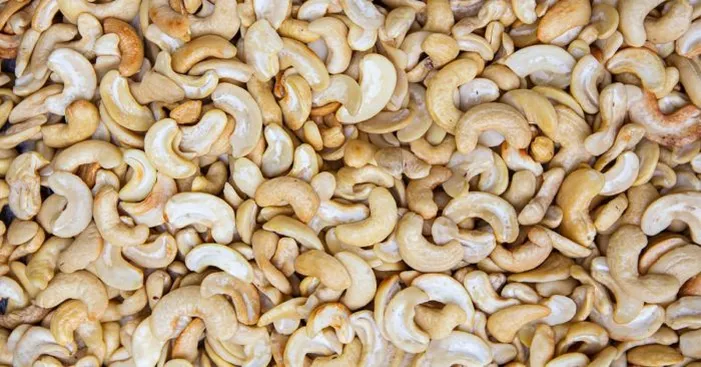
Kaju nuts are not only one of the best-tasting nuts but also one of the most nutritious ones.
Most people get tricked with dried fruits in general as they can easily be over-consumed.
A general tip is to consume no more than a handful of any dried fruit like almonds, walnuts, pistachios, pines, kaju…
Also, we need to be more careful about eating kaju especially when we are taking medications as there are possibilities of interactions.
In this article, w gathered all the useful information you need to know about kaju nuts nutritional values, health benefits, and possible side effects, alongside tips on how to buy + consume + store them.
However, let’s have a brief dive into the history of kaju!
Kaju nuts: a historical overview
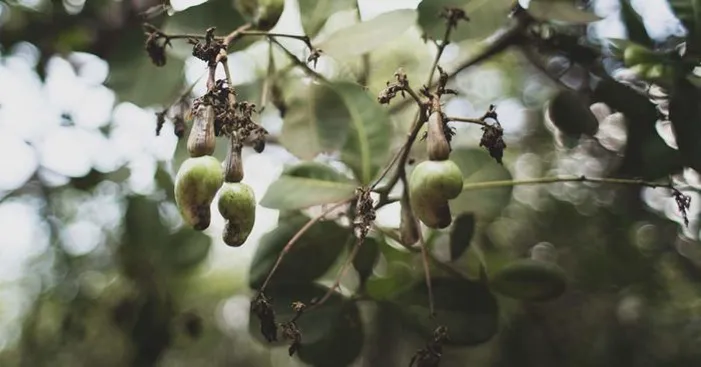
Kaju nuts AKA “cashews” grows in the Anacardium occidentale tree which is native to Brazil in the region between the Atlantic and the Amazon.
The word Anardier actually means “upside-down heart” in the Greek language and it’s because of the shape Kaju fruits.
Historical records show that South American Andeans used to consume kaju and they were the first humans to domesticate these species of trees.
In modern history, the first mention of Kaju was in 1538 during the Portuguese conquests in South America.
The European conquerors fell in love with these nuts and brought them back to their colonies across Asia and Africa.
Nowadays, those colonies are the largest producers of kaju nuts across the world.
In fact, more than 90% of kaju fruits grow in Africa and then get transported to Vietnam and India where they take the nuts out and export them globally.
Since 2003, Kaju nuts are the 2nd most-produced oleaginous fruit worldwide after almonds.
How many can we eat?
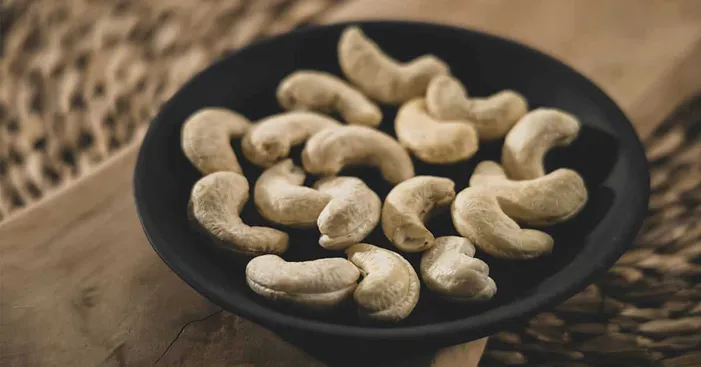
Regardless of the rich nutritional composition of kaju nuts, we shouldn’t overconsume them.
In fact, according to the NHS, we should consume no more than a handful of oleaginous fruits (almonds, pistachios, kaju, pine…) per day (about 20g).
This is probably because these types of nuts are nutritionally dense and offer a lot of nutrients in a small size.
In other words, 3 ounces of Kaju may seem like a small quantity but it is about 470 calories and 37g of fats which are more than rice, pasta, chicken, pizza…
Kaju nuts benefits and nutritional values:
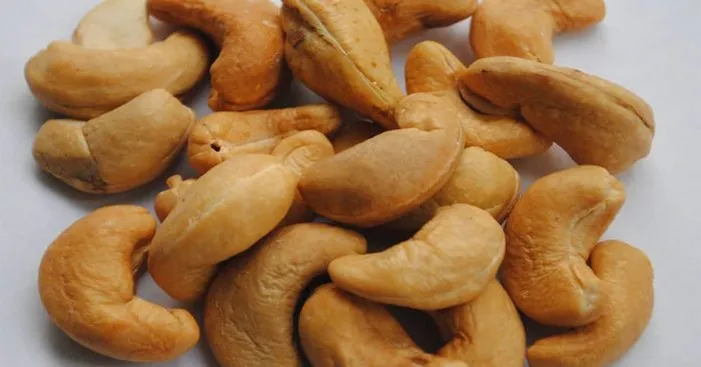
Nutritional values:
The delicious kaju nuts are basically among the most nutritious oleaginous nuts you could ever find!
It is a great source of protein, antioxidants, vitamins, minerals, and other plant components.
Kaju offers about 10% of the daily needs of protein in just a serving of 20g (handful).
That serving also comes with 9.2g of carbs, 1.6g of sugar, and 157 calories all needed to provide energy for physical activities.
In addition, that handful of kaju also offers minerals such as copper, iron, magnesium, manganese, selenium, and phosphorus.
It also comes with good amounts of unsaturated fats and vitamins like vitamin K and vitamins from the B group.
These nutritional data counts for a serving of 1 ounce (handful, 28g) of unroasted and unsalted kaju nuts:

- Calories: 155
- Fibers: 1g
- Protein: 5.1g
- Carbs: 9.2g
- Fat: 12.3g
- K vitamin: 12%
- B1 Vitamin: 8%
- B6 Vitamin: 6%
- B9 Vitamin: 2%
- Calcium: 1%
- Iron: 10%
- Phosphorus: 17%
- Potassium: 5%
- Magnesium: 20%
- Zinc: 11%
- Copper: 31%
- Selenium: 8%
- Manganese: 23%
Health benefits of Kaju:
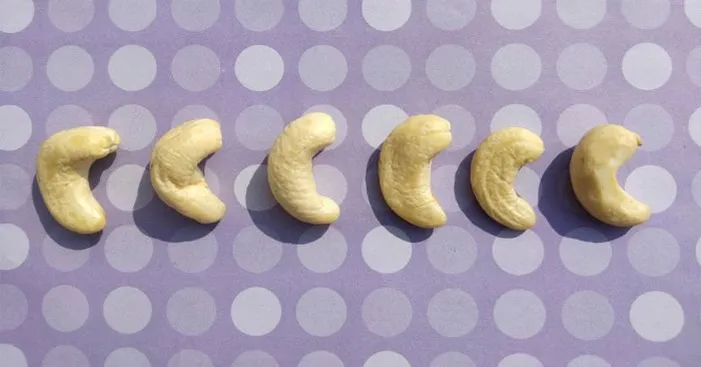
Good for the heart:
Kaju nuts are a good source of polyunsaturated fatty acids which are necessary to form cell membranes.
In addition, these fats have a good impact on the heart by preventing the risk of strokes and cardiovascular diseases.
A 2019 study shows that consuming oleaginous nuts 3 to 4 times a week reduces the risk of dying from a heart attack by 17%.
This is because polyunsaturated fats content reduces bad cholesterol in the blood which prevents plaque formation and allows a smooth blood flow.
Strengthens the bones:
Kaju nuts are a good source of magnesium about 20% per serving (handful, 20g) and this mineral promotes bone density.
With few traces of calcium and sodium, consuming these nuts will also eliminate any bone weakness and micro fractures.
In addition, eating kaju also helps speed up the healing process of broken or fractured bones.
Helps maintain a good memory:
These nuts are a very good ally to memory as they contain nutrients and trace elements that maintain and sharpen memory.
This is very beneficial, especially for children and the elderly that are more vulnerable to memory loss.
In fact, many studies show the efficiency of magnesium in maintaining and improving mental capacity including memory.
To sharpen your memory, you can introduce kaju nuts into your diet to ensure that you are meeting your daily needs for magnesium.
Good for diabetics:
In our modern world, diabetes became a very common disease worldwide and these problems even occur in young people as well.
Regular consumption of kaju nuts can lower the risk of diabetes and mostly control an already existing one.
The nutrients in these nuts help control the amount of glucose in the blood naturally.
Nonetheless, people with diabetes should not consume too many of them and they should limit their consumption to 4 or 5 nuts per day.
Also, it is advised to ask your doctor before you consume them to regulate the dose and avoid interactions with drugs.
Promotes weight loss:
Kaju nuts not only promote weight loss but also helps in the case of being underweight by balancing it by repairing the body’s metabolism.
In other words, these nuts normalize the appetite and feeling of hunger thanks to their fibrous content.
In addition, they regulate the digestive process which makes sure the body is not storing unnecessary fats.
May prevent cancer:
Just like diabetes, cancer is one of the most common life-threatening diseases worldwide but it can still be prevented.
Kaju nuts are a good source of antioxidants that can prevent cancerous bacteria from infecting healthy cells.
However, this doesn’t mean that Kaju is a cure for cancer but it can promote healthy body cells and keep cancer out of the body.
Relieves constipation:
Kaju nuts work like magic in the case of constipation, it’s as simple as that!
Indeed consuming a handful of kaju won’t give you a 100% of your daily need for fibers but it will certainly make sure you reach it.
In fact, constipation and diarrhea are both a result of irregular digestion processes due to the lack of fibers.
By getting enough fibers, the digestive system finds it easier to construct healthy stools that facilitate bowel movement and relieve constipation.
Promotes healthy blood:
Kaju nuts are a good source of many nutrients that have a good impact on the property of the blood.
For instance, a handful of these nuts may seem not too much but it offers 10% of the daily need for Iron.
Iron is an essential trace element needed to produce red blood cells and maintains the blood volume needed to carry oxygen.
In fact, 70% of the Iron we consume is used to make blood and any deficiency in this mineral could lead to serious issues like anemia.
Other health benefits of Kaju:
- Enhances cognitive abilities.
- Encourages wound healing.
- Lowers body temperature.
- Stabilizes the body’s metabolism.
- Strengthens heart muscles.
- Maintains healthy hair & nails.
- Activates the immune system.
- Stimulates hormones and enzyme production.
Possible side effects:

Kaju nuts are safe to consume especially with moderate consumption however, there are some exceptions for certain people.
Hypertension:
For instance, hypertensive people should only consume these nuts after asking their doctor.
This is caused by most of the kaju nuts in the market as they are sold after being salted which may raise sodium levels in the blood.
Unsalted kaju is always a better choice as 1ounce (28g) only contains 5mg of sodium while salted kaju nuts have 75g for the same weight.
That is 30 times more than the maximum daily dose of sodium and can lead to a rise in blood pressure, strokes, and heart disease.
Allergy:
It is totally forbidden to consume kaju for those who have an allergy since the nut is full of allergens.
According to a study made by the “Allergy” journal in 2003, the most vulnerable group of people are children as they can be allergic to kaju even though they never tried it before.
Another study made by “The archives of Disease in Childhood” in 2005 raises an alert about the possible Kaju allergic reactions.
The results show that kaju allergy has stronger symptoms than peanut allergy as it often leads to airway constriction and anaphylactic reaction.
Interaction with some drugs:
Kaju nuts are rich in many nutrients including magnesium with more than 20% of the daily need per ounce.
According to research made by the University of Maryland Medical Center, magnesium can interact with certain drugs.
The study confirms that magnesium interacts with antibiotics as it prevents the proper absorption of the drug.
In addition, magnesium can also interact with blood pressure drugs and cause fluid retention and a feeling of nausea.
Not only that but the high dose of magnesium in such nuts can interact with many other medications such as:
- Thyroid gland drugs.
- Diabetes drugs.
- Diuretics drugs.
Thus, if you notice magnesium in the list of concerns of any medication, that simply means do not consume kaju with it.
Possible intoxication from fresh Kaju:
Fresh Kaju fruits contain a phenolic resin that is toxic to the human body.
This is why you should never try to get the nuts out of the fruits or pick the fruit from its tree.
In fact, any skin contact with any part of the tree including leaves can cause allergic reactions ranging from asthma attacks to dermatitis.
Because of that, it is strictly not recommended to consume fresh kaju nuts as they can be poisonous and even lead to death in severe cases.
Instead, make sure you buy Kaju that are already peeled from their fruit and have undergone a heat treatment to ensure they are free from toxins.
Consuming Kaju nuts:

The vast majority of people like to consume kaju nuts roasted and salted which is not the healthiest way.
However, these nuts can be used to enhance the flavor of many dishes including pes, meat, salads, rice, and tajines.
For those who like pastries, these nuts are also perfect with brownies, cakes, muffins, and cookies.
There are some exotic uses of kaju like making wine or oil but these two are expensive and rare to find.
Nonetheless, the base point is that you can use them in both sweet and savory dishes.
Kaju nuts purée:
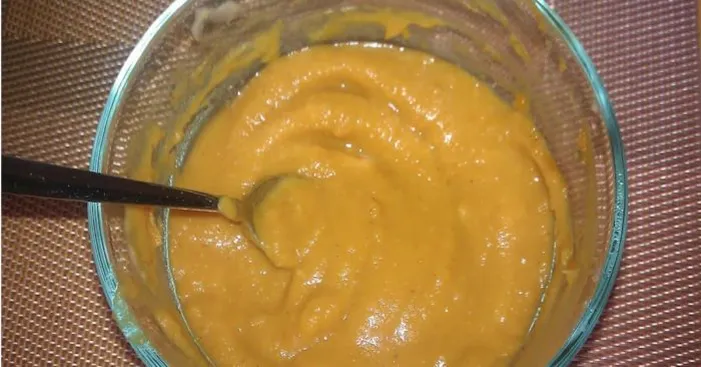
Ingredients:
- 1lb of unroasted kaju nuts (450g).
- ½ cup of water.
- 1 tbsp of cocoa.
- 2 tbsp of sugar.
- 1tsp of salt.
Preparation:
- Pour the fresh nuts into a blender and grind them for 3 minutes.
- Now add water, cocoa, sugar, and salt then blend them on a high speed for another 3 minutes.
- You should obtain a creamy paste and if not you can always blend them again and again until you get a yummy kaju purée.
Roasting Kaju nuts:
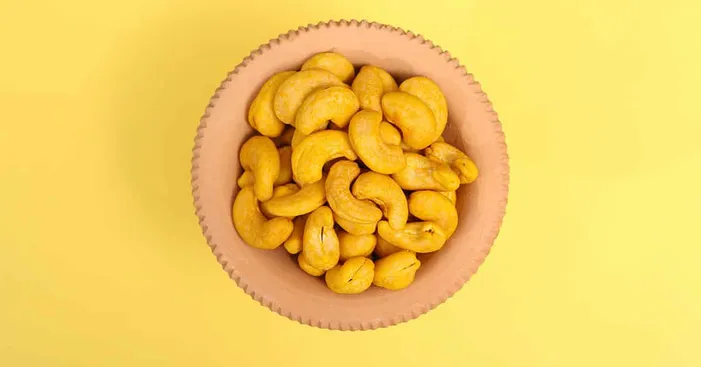
- Start by preheating the oven to 350°F (180°C).
- Get an oven tray and cover it with a baking sheet.
- Put the cashews on the tray and then pour 2 tbsp of vegetable oil (sunflower oil preferably as it has no smell).
- Using a spoon, mix the Kaju nuts and make sure they are all covered with oil.
- Now place the tray in the oven for 5 minutes.
- Take out the tray, and add 1 more tbsp. of vegetable oil and stir well.
- Put the tray in the oven for 3 more minutes then take them out to stir.
- Nuts in general should take no more than 15 minutes to be roasted, just make sure you stir every 3 to 5 minutes to avoid them getting burnt.
- When the nuts have a golden yellow color, you can take the tray out of the oven, cover it with a piece of cloth and let it cool down.
- This is the healthiest way to roast your kaju nuts as they are only halfway cooked which means they still have their nutrients and with no added salt.
Buying Kaju nuts:
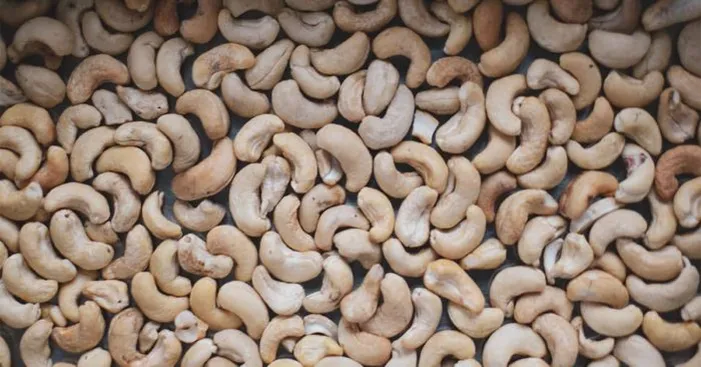
Raw Kaju is almost impossible to find in the market as the vast majority are sold roasted.
You can find both salted and unsalted roasted kaju nuts at Walmart or any other grocery store.
Also, you can find them as whole nuts or crushed into pieces which are more convenient for pastry recipes.
As for the method of roasting, in some places, you can also find dry roasted kaju nuts that have been cooked without oil.
This is the best choice if you are on a diet to lose weight as dry roasted kaju nuts have the least amount of fats.
It is also very common to find them sold in packaging whether it’s a sealed bag, plastic containers, or glass jars.
In the case of buying packaged kaju you just need to read the label and make sure that the package is intact and not expired.
In addition, you need to know that kaju in glass jars stays fresh more than in plastic containers and sealed bags.
Another tip to look for is to make sure there are no water droplets inside the container or insects.
Storing Kaju nuts:
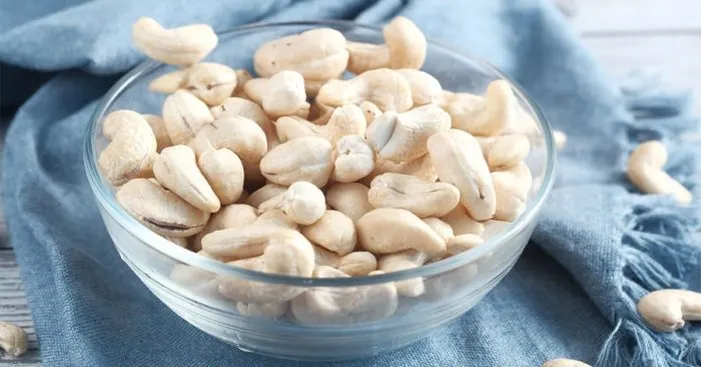
The two most abundant components in kaju are oil and oleic acid.
The good thing is that oleic acid extends the lifespan of kaju compared to other nuts including peanuts, almonds, and pistachios.
Nonetheless, it is the same reason that makes Kaju go rancid quicker than most nuts when it’s stored in bad conditions.
For instance, Kaju nuts need to stay away from humidity and light otherwise they don’t last even a week.
The best way to store such nuts is to put them in a dark glass jar and the kitchen pantry or fridge.
Away from humidity and light, they can last up to 6 months in the fridge and up to a year in the freezer.

q6rczj